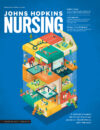There’s little question about the need of more diversity in the nursing workforce to match that found increasingly among patient populations. But how do you build a nursing education environment that will attract such diversity? For starters, stop using all-white manikin “patients” for simulation training, according to former faculty member Cynthia L. Foronda, PhD, RN, Assistant Professor Diana-Lyn Baptiste, DNP, MSN, RN, and Simulation and Nursing Lab Manager Jessica Ockimey. That canbe a challenge, though, they report in “As Simple as Black and White: The Presence of Racial Diversity in Simulation Product Advertisements.”
There’s little question about the need of more diversity in the nursing workforce to match that found increasingly among patient populations. But how do you build a nursing education environment that will attract such diversity? For starters, stop using all-white manikin “patients” for simulation training, according to former faculty member Cynthia L. Foronda, PhD, RN, Assistant Professor Diana-Lyn Baptiste, DNP, MSN, RN, and Simulation and Nursing Lab Manager Jessica Ockimey. That can be a challenge, though, they report in “As Simple as Black and White: The Presence of Racial Diversity in Simulation Product Advertisements.”
The U.S. Census Bureau reported in 2012 that 37 percent of those in the general population identify as minority. Yet only 19 percent of registered nurses do the same.
The authors report that the National League for Nursing has called for “action to create inclusive academic environments that foster recruitment, retention, and graduation of diverse students.” But try finding the non-white manikins:
“Of the catalogues/brochures reviewed, 2,035 body parts were identified. Ninety-four percent of the body parts were White and 6% were Black. The catalogues/brochures included 395 full-sized manikins. Again, 94% of the manikins were White and 6% were Black. When evaluating the materials to consider the people or models in the background, either holding a body part or demonstrating use of a product, 92% were White and 8% Black. In reviewing the photos of the manikins on exhibit, 90% were White and 10% were Black. Forty-seven body parts were on display and 96% were White and 4% were Black. Four virtual simulators or avatars on computer screens were captured and 100% were White.”
Publication: Clinical Simulation in Nursing

